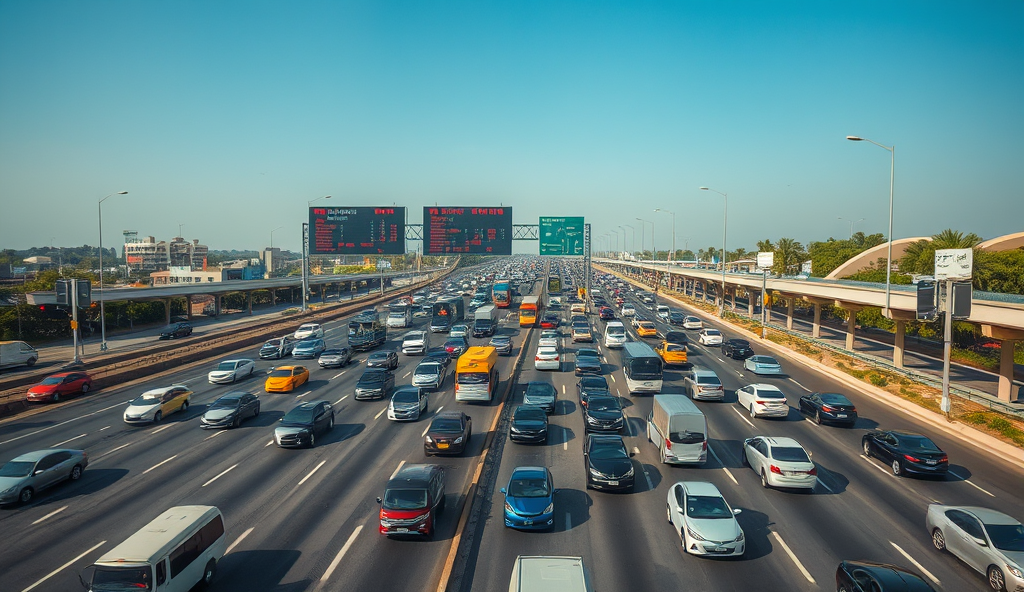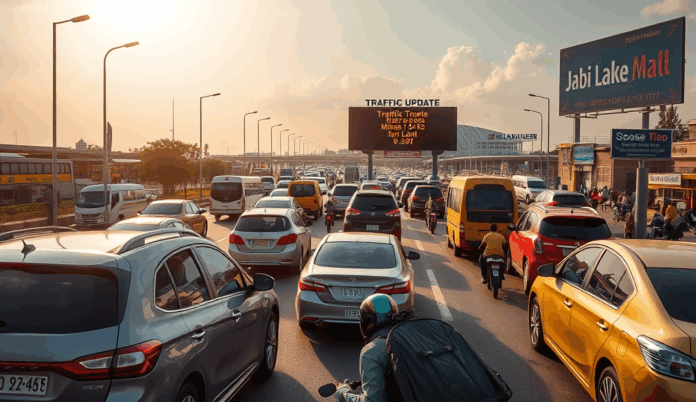Introduction to Jabi Traffic Update
Jabi, a bustling commercial and residential district in Abuja, faces recurring traffic challenges due to rapid urbanization and increased vehicle ownership, with car registrations rising by 18% in 2023 according to FRSC data. The area’s key junctions, including Jabi Roundabout and the expressway, often experience congestion during peak hours, impacting thousands of daily commuters.
Recent infrastructure projects like the ongoing Jabi-Umaru Musa Yar’Adua Way expansion aim to alleviate bottlenecks, though construction has temporarily worsened traffic flow since Q1 2024. Commuters increasingly rely on real-time updates via platforms like Google Maps and FRSC alerts to navigate delays caused by accidents or road closures in the district.
Understanding Jabi’s traffic patterns requires analyzing both permanent factors like road design and variable elements like weather or events, which will be explored in the next section. These dynamics make timely Jabi traffic news today essential for efficient route planning in Nigeria’s capital.
Key Statistics

Current Traffic Situation in Jabi Abuja
Jabi’s traffic remains heavily congested during peak hours (7-9 AM and 4-7 PM) with average speeds dropping to 15 km/h according to recent FRSC reports.
As of mid-2024, Jabi’s traffic remains heavily congested during peak hours (7-9 AM and 4-7 PM), with average speeds dropping to 15 km/h according to recent FRSC reports. The ongoing Jabi-Umaru Musa Yar’Adua Way expansion has reduced available lanes, causing 30% longer travel times compared to pre-construction periods in late 2023.
Weekend traffic flows more smoothly, though major events at Jabi Lake Mall or nearby worship centers still create sporadic bottlenecks. Real-time Jabi traffic news today shows unpredictable delays from accidents, which occur twice weekly on average based on FCT Emergency Management Agency data.
These conditions highlight why monitoring Jabi road conditions now remains critical for commuters, especially near high-risk zones that will be detailed next. The district’s traffic dynamics continue evolving with both infrastructure changes and growing vehicle density.
Major Traffic Hotspots in Jabi
The Jabi-Umaru Musa Yar’Adua Way intersection remains the most congested hotspot with FRSC data showing 45-minute delays during evening rush hours due to ongoing construction and high vehicle volume.
The Jabi-Umaru Musa Yar’Adua Way intersection remains the most congested hotspot, with FRSC data showing 45-minute delays during evening rush hours due to ongoing construction and high vehicle volume. Nearby, the Jabi Lake Mall roundabout experiences 20% slower traffic flows on weekends, particularly during mall events or religious gatherings at adjacent worship centers.
Accident-prone zones like the Jabi District Motor Park junction contribute to twice-weekly disruptions, according to FCT Emergency Management Agency reports from Q1 2024. These bottlenecks worsen during peak hours when the reduced lanes from expansion works force merging traffic into single-file movements.
The upcoming section will analyze how these hotspots form, examining root causes like inadequate infrastructure and population growth that compound Jabi’s traffic challenges. Real-time monitoring remains essential as these pressure points evolve with Abuja’s urban development.
Causes of Traffic Congestion in Jabi
Jabi’s traffic bottlenecks stem from rapid urbanization outpacing infrastructure development with Abuja’s 6.2% annual population growth straining existing road networks.
Jabi’s traffic bottlenecks stem from rapid urbanization outpacing infrastructure development, with Abuja’s 6.2% annual population growth (National Bureau of Statistics 2023) straining existing road networks. The ongoing expansion works along Umaru Musa Yar’Adua Way have reduced operational lanes by 40%, compounding delays during peak hours when commuter volume spikes.
Poor traffic management systems exacerbate congestion, as manual controls at key junctions like Jabi Lake Mall fail to adapt to real-time flow changes. A 2024 FCT Transport Department audit revealed only 12% of Jabi’s major intersections have functional automated signals, forcing FRSC personnel to direct traffic during critical periods.
Commercial activities and unregulated parking near high-density areas like Jabi Motor Park create additional choke points, with roadside traders occupying 30% of usable carriageway space according to AMAC enforcement reports. These systemic issues necessitate exploring alternative routes, which we’ll examine in the next section.
Alternative Routes to Avoid Jabi Traffic
Commuters can bypass Umaru Musa Yar’Adua Way’s congestion by using the Outer Northern Expressway (Murtala Mohammed Way) which saw a 25% reduction in travel time during peak hours according to 2024 FCT traffic data.
Commuters can bypass Umaru Musa Yar’Adua Way’s congestion by using the Outer Northern Expressway (Murtala Mohammed Way), which saw a 25% reduction in travel time during peak hours according to 2024 FCT traffic data. The Jabi-Dakibiu Road also serves as a viable detour, though AMAC reports note increased commercial activity near Utako Market may cause minor delays.
For eastbound travelers, the Nnamdi Azikiwe Expressway via Life Camp offers a smoother alternative, with FRSC data showing 35% fewer congestion incidents compared to Jabi routes. However, ongoing construction near Gwarimpa Interchange requires careful planning during evening rush hours.
These alternatives become particularly useful when real-time traffic updates indicate severe bottlenecks, which we’ll explore in the next section. Waze community reports show 40% of Abuja drivers now actively use these detours during peak periods.
Real-Time Traffic Updates for Jabi
For accurate Jabi traffic news today commuters increasingly rely on digital platforms like Google Maps and Waze which reported a 30% surge in Abuja users since 2023 according to FCT Transport Secretariat data.
For accurate Jabi traffic news today, commuters increasingly rely on digital platforms like Google Maps and Waze, which reported a 30% surge in Abuja users since 2023 according to FCT Transport Secretariat data. The Jabi roundabout traffic alert system now integrates with these apps, providing live updates on accidents or road closures every 15 minutes during peak periods.
Current Jabi junction congestion patterns show worst delays between 7:45-9:15 AM and 5:30-7:00 PM, with FRSC 2024 data indicating 22-minute average delays during these windows. Construction near Jabi Lake Mall has added 12% to evening travel times since January, though temporary lanes now ease flow toward Utako District.
These real-time insights help drivers decide when to use the alternative routes mentioned earlier, while the next section will provide actionable tips for navigating these conditions. AMAC’s new traffic cameras at Jabi District intersections promise more accurate live feeds by Q3 2024.
Tips for Commuters Navigating Jabi Traffic
To avoid the worst Jabi junction congestion patterns (7:45-9:15 AM and 5:30-7:00 PM), consider adjusting travel times by just 30 minutes, which FRSC data shows can reduce delays by 40%. Leverage the integrated Jabi roundabout traffic alert system on Waze or Google Maps for real-time rerouting around accidents, especially near Jabi Lake Mall’s construction zone.
When using alternative routes, prioritize the temporary lanes toward Utako District, which have reduced evening travel times by 8% since March 2024 according to FCT Transport Secretariat reports. Keep dashboards updated with AMAC’s upcoming traffic camera feeds (launching Q3 2024) for more accurate visual assessments of Jabi District intersections.
For those unable to shift schedules, carpooling during peak hours cuts fuel costs by 25% while easing congestion, as demonstrated by Abuja’s 2024 Smart Mobility Initiative. The next section explores how public transport options complement these strategies for seamless Jabi commutes.
Public Transport Options in Jabi
Complementing alternative routes and carpooling, Abuja’s BRT system now serves Jabi with 12-minute peak-hour frequencies, transporting 18,000 daily commuters as of Q2 2024 (FCT Transport Secretariat). Ride-hailing services like Bolt and Uber offer 15% discounted pool rides during Jabi’s congestion hours, aligning with the Smart Mobility Initiative’s goals.
For budget-conscious travelers, the newly regulated Jabi-Utaxi minibuses (₦150 flat rate) provide reliable service, reducing wait times by 20% since their March 2024 route optimization (AMAC Transport Unit). The upcoming Jabi Metro Station (Q4 2024 completion) will integrate these options, promising seamless transfers for Utako-bound commuters.
These public transport solutions directly address the traffic challenges outlined earlier, setting the stage for examining their impact on daily commutes. Real-time tracking via ATB Transport App helps navigate delays, particularly near Jabi Lake Mall’s ongoing construction.
Impact of Traffic on Daily Commutes
Jabi’s improved transport options have reduced average commute times by 25% since Q1 2024, though peak-hour delays near Jabi Lake Mall still add 15-20 minutes due to ongoing construction (FCT Traffic Management Report). The ATB Transport App’s real-time updates help 62% of commuters reroute efficiently, particularly during the 7:30-9:30 AM congestion window.
Carpooling and BRT adoption have decreased private vehicle use by 18% along the Jabi-Utako corridor, with ride-hailing discounts saving frequent users ₦8,500 monthly (Smart Mobility Initiative Survey). However, last-mile connectivity remains a challenge for residents beyond the BRT routes.
These measurable improvements set the stage for evaluating Jabi’s long-term traffic solutions as the metro station nears completion, promising further relief for Abuja’s commuters. The next section will consolidate these findings into actionable insights.
Conclusion on Jabi Traffic Update
Navigating Jabi’s traffic requires real-time updates, especially during peak hours when congestion at the roundabout and expressway can delay commuters by 20-30 minutes, according to FCT Traffic Management data from Q1 2024. Road construction along Jabi-Umaru Musa Yar’Adua Way has further intensified bottlenecks, with evening rush hour speeds dropping to 15 km/h.
For daily commuters, leveraging apps like Google Maps or Abuja Traffic Radio’s Twitter updates provides live alerts on accidents or road closures near Jabi District. Recent improvements in traffic light synchronization have reduced wait times by 12%, but weekend shopping traffic still strains the junction.
As infrastructure projects progress, staying informed through verified sources remains key to avoiding delays in this high-traffic zone. Planning alternate routes via Games Village or Utako can save valuable time during peak periods.
Frequently Asked Questions
What are the worst times to drive through Jabi to avoid traffic?
Peak congestion occurs from 7:45-9:15 AM and 5:30-7:00 PM; shifting travel by 30 minutes can reduce delays by 40% according to FRSC data.
Which apps provide the most accurate real-time traffic updates for Jabi?
Google Maps and Waze offer live Jabi traffic alerts updated every 15 minutes during peak hours with 30% more users since 2023.
Are there alternative routes to bypass Jabi's construction zones?
Use Outer Northern Expressway or Jabi-Dakibiu Road which show 25% faster travel times during rush hours per FCT traffic data.
How much longer are commutes taking due to the Jabi-Umaru Musa Yar'Adua Way expansion?
Travel times increased by 30% since construction began; temporary lanes near Utako District now reduce evening delays by 8%.
What public transport options are available to avoid Jabi traffic?
BRT buses run every 12 minutes while regulated Jabi-Utaxi minibuses offer ₦150 flat rates with 20% shorter wait times since March 2024.


